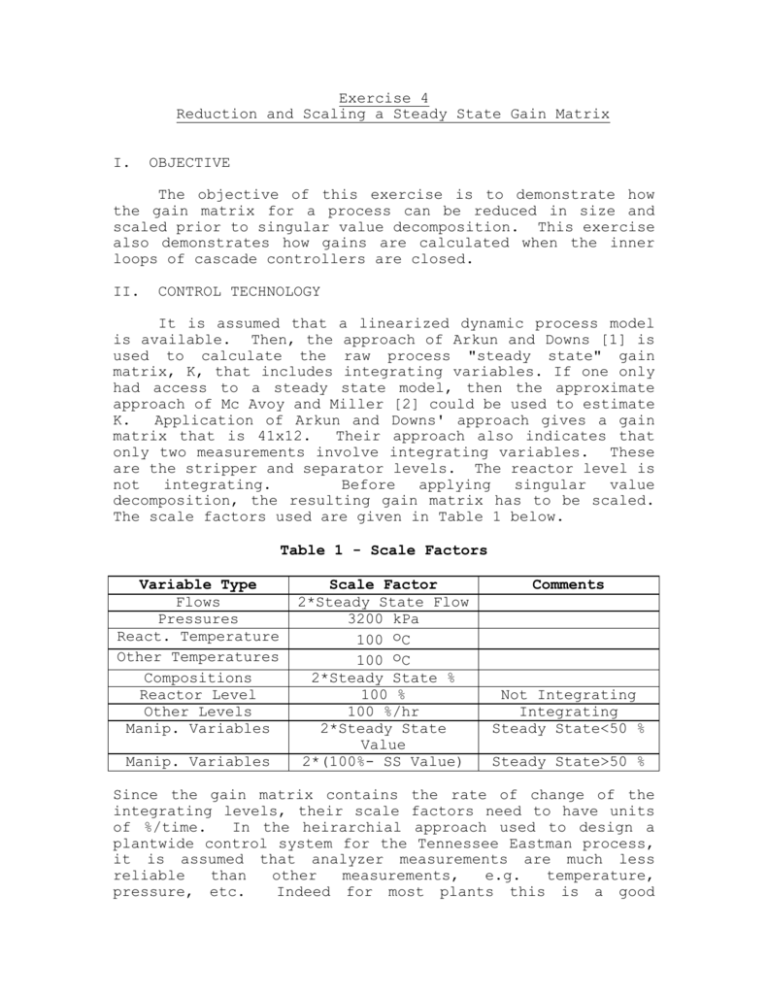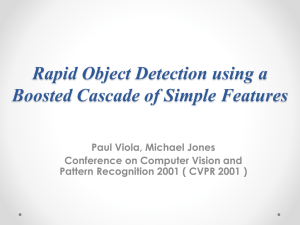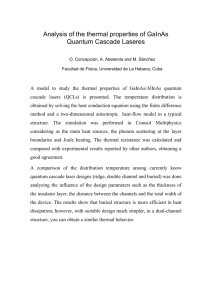Exercise_4
advertisement

Exercise 4 Reduction and Scaling a Steady State Gain Matrix I. OBJECTIVE The objective of this exercise is to demonstrate how the gain matrix for a process can be reduced in size and scaled prior to singular value decomposition. This exercise also demonstrates how gains are calculated when the inner loops of cascade controllers are closed. II. CONTROL TECHNOLOGY It is assumed that a linearized dynamic process model is available. Then, the approach of Arkun and Downs [1] is used to calculate the raw process "steady state" gain matrix, K, that includes integrating variables. If one only had access to a steady state model, then the approximate approach of Mc Avoy and Miller [2] could be used to estimate K. Application of Arkun and Downs' approach gives a gain matrix that is 41x12. Their approach also indicates that only two measurements involve integrating variables. These are the stripper and separator levels. The reactor level is not integrating. Before applying singular value decomposition, the resulting gain matrix has to be scaled. The scale factors used are given in Table 1 below. Table 1 - Scale Factors Variable Type Flows Pressures React. Temperature Other Temperatures Compositions Reactor Level Other Levels Manip. Variables Manip. Variables Scale Factor 2*Steady State Flow 3200 kPa 100 oC 100 oC 2*Steady State % 100 % 100 %/hr 2*Steady State Value 2*(100%- SS Value) Comments Not Integrating Integrating Steady State<50 % Steady State>50 % Since the gain matrix contains the rate of change of the integrating levels, their scale factors need to have units of %/time. In the heirarchial approach used to design a plantwide control system for the Tennessee Eastman process, it is assumed that analyzer measurements are much less reliable than other measurements, e.g. temperature, pressure, etc. Indeed for most plants this is a good assumption to make. A byproduct of making this assumption is that the resulting control system should be the best possible if for some reason the analyzer becomes inoperable. In this exercise only the non-analyzer loops are considered. The non-analyzer measurements involve the first 22 measurements, and thus only the first 22 rows of the raw "steady state" gain matrix are used. Eliminating the analyzer gives a 22x12 gain matrix. Ten of the rows of the resulting 22x12 matrix involve the gains for the inner loops of the cascade controllers that will be closed. These variables are shown in Table 2 below. Table 2 - Inner Cascade Measurements Measurement Row Number A Flowrate D Flowrate E Flowrate C Flowrate Purge Flowrate Separator Exit Flow Product Flowrate Steam Flowrate React.CW Outlet Temp React.CW Outlet Temp 1 2 3 4 10 14 17 19 21 Manipulated Variable 3 1 2 4 6 7 8 9 10 22 11 The inner cascade measurements can be eliminated serially as follows. First start with the A Flowrate, which involves measurement 1 and manipulated variable 3. The initial 22x12 gain matrix can be written as: xmeas K *u (1) If xmeas for the flowrate of A is set to FAset then the first row of eqn. 1 can be solved for u3, the signal going to the A valve, as: 12 set u3 F A K1, ju j / K1,3 j1 j 3 (2) Using eqn. 2 one can eliminate u3 as a manipulated variable in favor of FAset . Elimination of u3 gives a new gain matrix whose elements are: Ki, j Ki, j Ki, 3 * K1, j / K1,3 / j 3 (3) Ki,3 / Ki,3 / K1,3 and u / u FAset u / / (4) where u' and u'' contain all the original manipulated variables, except u3. Since u3 has been eliminated in favor of FAset , the dimension of K' is 22x12 and its third column gives the gain elements for manipulating FAset . The first row of K' has zeros in every column except the column associated with u3 which has a 1. In the computer exercise, the correct column for a manipulated variable can be determined by examining the MATLAB variable, Glabel (for gain label). Next the D flowrate can be eliminated by taking the same approach as was done for A, but now using the K' matrix. In this manner each of the inner cascade measurements can be eliminated one at a time. If variable then the rows are III. all the rows that involve the cascade set point affecting itself with a unity gain are eliminated, resulting gain matrix is reduced to 12x12, i.e. the reduced by 22 minus 10 cascaded measurements. COMPUTER EXERCISE This exercise involves the use of a number of MATLAB routines. First the raw gain matrix, K, can be loaded into memory using the mat-file TEgain.mat. K is the 41x12 raw gain matrix. Labels can be determined for the rows and columns of K by calling the m-file Glabel=gainlbl. Glabel is a 42 row array which has a header and which gives all the measurements and manipulated variables. The raw gain matrix can be scaled by calling the m-file k=scale(K,u,zs), with the scaled gain matrix, k, returned. Before calling scale the mat file steady needs to be loaded. At this point rows 23 to 41 (analyzer rows) can be eliminated from k and rows 24 to 42 can be eliminated from Glabel by a simple MATLAB command (k=k(1:22,:), and Glabel=Glabel(1:23,:)). To carry out the serial elimination of the inner cascade measurements, the m-file, [kp,Glabel]= cascade1(k,Glabel), can be used. This m-file asks which cascade manipulated variable, m, is being considered, and it returns kp, the gain matrix resulting from closing the cascade loop on the measurement of m's effect (a flowrate, or temperature). Be careful with inputs and outputs to the cascade1 m-file so that you don't erase an earlier result. The input k needs to be set to kp after each cascade loop is closed. The matrix of labels, Glabel, is updated by cascade1. The final 12x12 scaled gain matrix can be calculated by calling the mfile, [k,Glabel]=elim(k,Glabel), which eliminates the rows associated with the inner cascade measurements. IV. EXERCISES Exercise 1. Load the raw gain matrix for the process, TEgain.mat. Display the gain labels using gainlbl. Scale the raw gain matrix using scale, and eliminate rows 23 to 41 in the scaled matrix, k, as well as rows 24 to 42 in the label matrix, Glabel. Exercise 2. Starting with the scaled gain matrix for the non-analyzer variables, eliminate the inner cascade measurements, shown in Table 2, using cascade1. As each variable is eliminated check its associated row. Exercise 3. Eliminate the rows associated with the inner cascade measurements using elim. V. RESULTS ANALYSIS After all the inner cascades are eliminated, verify that the rows associated with all inner cascade loops form a perturbed version of an identity matrix. What does this result tell you about the process of closing cascade loops? Compare your final 12x12 gain matrix to that given in the mat-file TEresult. If the cascade variables (yc, uc) and the non-cascade variables (y, u) are separated in the original gain matrix as: yc AC , A12 uC y A21 , A22 u develop a general expression for the gain matrix results from closing the inner cascade controllers. VI. REFERENCES: (5) that [1] Arkun, Y. and J. Downs, "A General Method to Calculate Input-Output Gains and the Relative Gain Array for Integrating Processes," Computers Chem. Engng., 14(10), 1101-1110 (1990). [2] Mc Avoy, T., and Miller, R., "Incorporating Integrating Variables Into Steady State Models For Plantwide Control Analysis and Design", I&EC Research, 38, pp. 412-420 (1999).








